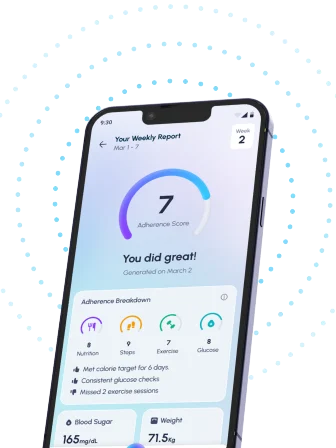Table of Contents
- Understanding Fructose and Its Impact on Diabetes
- Hidden Fructose: Sneaky Sources to Avoid in Your Diet
- Diabetes-Friendly Diet: A Guide to Fructose-Free Eating
- Swap Sugary Drinks: Better Beverage Choices for Managing Diabetes
- Create a Fructose-Conscious Meal Plan: Recipes and Tips
- Frequently Asked Questions
- References
Living with diabetes requires careful attention to diet, and understanding which foods to avoid is crucial for managing your blood sugar levels effectively. One often-overlooked culprit? Fructose! This blog post, Managing Diabetes: A Guide to Avoiding Fructose-Rich Foods, will equip you with the knowledge you need to navigate grocery aisles and meal planning with confidence. We’ll explore sneaky sources of fructose and offer practical tips for making healthier choices that support your overall well-being. Let’s work together to make managing your diabetes a little easier, one delicious (and fructose-free!) meal at a time.
Understanding Fructose and Its Impact on Diabetes
The Hidden Sugar Threat
Diabetes affects millions globally, and in regions like India and other tropical countries, managing this condition is particularly crucial. A significant contributor to diabetes risk is excess sugar consumption, with studies showing an 18% increase in risk associated with high sugar intake. In India, the average annual per capita sugar consumption stands at a concerning 20 kg per year, highlighting the need for greater awareness and dietary adjustments. This high intake often includes fructose, a type of sugar found naturally in fruits and added to many processed foods. Unlike glucose, fructose is primarily metabolized by the liver, potentially leading to increased fat storage, insulin resistance, and ultimately, a higher risk of developing type 2 diabetes.
Fructose in the Indian Diet: Common Culprits
Many popular foods and drinks in India and tropical countries are surprisingly high in fructose. Sweetened beverages, such as fruit juices, sodas, and sweetened teas, are major contributors. Processed foods like packaged snacks, sweets, and desserts often contain high-fructose corn syrup or other added sugars. Even seemingly healthy options, like some fruit-flavored yogurts and breakfast cereals, can contain significant amounts of added fructose. Be aware of hidden sugars lurking in seemingly innocuous products. Carefully examine food labels and opt for low-sugar alternatives.
Managing Fructose Intake for Better Diabetes Control
Reducing fructose consumption is vital for effective diabetes management. Prioritize whole, unprocessed foods, especially fresh fruits and vegetables. Consume fruits in moderation, as their natural sugars still contribute to overall carbohydrate intake. Choose water or unsweetened beverages over sugary drinks. Read food labels diligently, paying attention to added sugars and fructose content. Making these conscious choices can significantly reduce your risk of complications and improve your overall health. Remember, small changes in your diet can make a big difference in managing your diabetes effectively. The relationship between diet and diabetes is complex, and understanding the link between Understanding the Link Between Diabetes and Obesity is crucial for effective management. Furthermore, even seemingly innocuous choices like coffee consumption can impact blood sugar levels; you may find it helpful to explore the impact of Coffee for Diabetes: Risks, Benefits and Effects on Glucose Level.
Hidden Fructose: Sneaky Sources to Avoid in Your Diet
Unmasking Fructose in Popular Indian & Tropical Foods
Managing diabetes effectively often means navigating a minefield of hidden sugars. While we’re all aware of sugary sodas and desserts, the real challenge lies in identifying fructose lurking in unexpected places, especially prevalent in many Indian and tropical cuisines. Daily consumption of sugary beverages, for example, raises diabetes risk by 26%, highlighting the crucial role of mindful food choices. This is particularly important in regions like India and across the tropics where certain food preparations naturally incorporate higher levels of sugars.
Common Culprits in Your Kitchen
Many processed foods, popular in India and tropical countries, contain high levels of fructose. This includes sweetened juices, packaged snacks, and even some seemingly healthy options like certain fruit preserves or chutneys. Pay close attention to ingredient lists, looking out for terms like “high-fructose corn syrup,” “fructose,” and “sugar,” even in seemingly savory items. Be wary of sweetened yogurt drinks, flavored lassi, and certain types of bread. Even seemingly healthy fruit juices can contribute significantly to your daily fructose intake. Opt for whole fruits instead whenever possible to reduce your overall sugar intake. Learning How to Identify and Avoid Hidden Sugars in Processed Foods is a crucial first step.
Making Smart Choices
To successfully manage diabetes, particularly in tropical regions with abundant natural sugars, prioritize fresh, whole foods. Focus on lean proteins, vegetables, and whole grains. Learn to identify the hidden fructose in your diet, and choose low-sugar alternatives whenever available. Remember, a balanced diet rich in fiber and low in processed foods is key to controlling your blood sugar levels. Consult a doctor or registered dietitian for personalized advice tailored to your specific needs and dietary preferences. They can provide specific guidance on managing your diabetes within the context of your regional cuisine. You might also find Discover How Fermented Foods Help Regulate Blood Glucose Levels helpful in your journey.
Diabetes-Friendly Diet: A Guide to Fructose-Free Eating
Managing blood sugar levels is crucial for individuals with diabetes, and understanding your carbohydrate intake is key. While the recommended carbohydrate intake per meal varies (generally 45–60 grams for most, depending on individual needs and activity levels), limiting fructose is particularly important. Many commonly consumed foods in Indian and tropical countries are surprisingly high in fructose, posing a hidden threat to diabetes management.
Identifying Fructose Culprits in Your Diet
Fructose, a type of sugar found naturally in fruits and added to many processed foods, can significantly impact blood glucose levels. In India and other tropical regions, be mindful of seemingly healthy options that pack a fructose punch. Fresh fruit juices, though seemingly nutritious, often contain high concentrations of fructose. Similarly, many sweetened beverages, popular throughout the region, are loaded with added sugars, including fructose. Even seemingly healthy treats like dried fruits and some traditional sweets can contain surprisingly high levels of fructose. Pay close attention to labels and opt for whole fruits over juices whenever possible.
Making Smart Choices: Fructose-Conscious Eating in India and Tropical Regions
To manage your diabetes effectively, prioritize whole, unprocessed foods. Focus on meals rich in protein and healthy fats, and choose complex carbohydrates over simple sugars. Incorporate plenty of vegetables, lentils, and whole grains into your daily diet. When enjoying fruits, opt for those lower in natural sugars, and always consume them in moderation. Remember, portion control is vital. Consider consulting a registered dietitian or diabetes educator for a personalized meal plan tailored to your specific needs and preferences. They can help you navigate the diverse culinary landscape of your region and create a diabetes-friendly diet that is both delicious and effective. For further guidance on managing your weight alongside your diabetes diet, you might find How to Lose Weight with Diabetes Diet Plan helpful. Understanding the nuances of carbohydrate intake is also crucial, and exploring different approaches like those detailed in Low-Carb vs. Moderate-Carb Diets for Diabetes: What Works Best? can be beneficial.
Swap Sugary Drinks: Better Beverage Choices for Managing Diabetes
Managing blood sugar levels is crucial for individuals with diabetes, and a significant factor often overlooked is beverage consumption. Many popular drinks in Indian and tropical countries are surprisingly high in fructose, a type of sugar that can significantly impact blood glucose levels. This is especially important considering that 61% of people with diabetes are aged between 20-64 years, a demographic highly active in these regions.
Say Goodbye to Sugary Drinks
Traditional sweet drinks like sugarcane juice, readily available across many tropical and Indian markets, and commercially produced soft drinks are loaded with fructose and empty calories. These contribute to spikes in blood sugar, making it challenging to maintain healthy levels. Even seemingly harmless fruit juices can contain high fructose concentrations. Opting for healthier alternatives is crucial for effective diabetes management in this age group and beyond. The International Diabetes Federation highlights the growing concern of diabetes globally, impacting a significant portion of the 20-64 age group.
Embrace Healthier Hydration
Fortunately, there are plenty of delicious and refreshing alternatives. Water is the best choice for hydration, naturally calorie and sugar-free. Unsweetened herbal teas, like Tulsi (holy basil) tea common in India, or spiced ginger tea offer flavorful alternatives. Consider low-fat milk or unsweetened coconut water as occasional treats, mindful of their sugar content. Making conscious beverage choices is a simple yet powerful step towards better diabetes management. For those over 65 (representing 39% of those with diabetes), these changes are particularly beneficial for overall health. For more specific recommendations on drinks that can help lower blood sugar, check out Best Drinks for Diabetes to Lower Blood Sugar.
Regional Recommendations
Incorporating regionally appropriate options is key. For instance, in India, nimbu pani (lemonade) made without added sugar is a refreshing and healthy alternative. Similarly, exploring local fruits with lower sugar content and preparing homemade juices diluted with water can significantly reduce fructose intake. Remember to always check food labels and be mindful of portion sizes. Prioritizing healthy hydration is a vital component of managing diabetes effectively in Indian and tropical countries. And if you’re wondering about the role of alcohol, How to Safely Enjoy Alcohol While Managing Diabetes offers valuable insights.
Create a Fructose-Conscious Meal Plan: Recipes and Tips
Understanding Fructose and Blood Sugar Control
Managing diabetes in tropical and Indian climates requires a keen awareness of dietary fructose. Many popular fruits and processed foods common in these regions are surprisingly high in fructose, leading to unpredictable blood sugar spikes. Remember, ideal pre-meal blood sugar levels are 80–130 mg/dL, and post-meal levels should remain below 180 mg/dL. A fructose-conscious meal plan helps maintain these levels consistently.
Incorporating Region-Specific Foods
Focus on incorporating low-fructose, nutrient-rich options readily available in India and tropical countries. For example, prioritize meals centered around lentils (dal), vegetables like bitter gourd (karela) and spinach (palak), and lean protein sources like fish and chicken. These provide essential nutrients without significantly impacting blood sugar. Consider using spices like cinnamon and turmeric, known for their potential blood sugar-regulating properties.
Sample Meal Plan Ideas
A typical breakfast could be idli with sambar (a lentil-based stew) and a small portion of coconut chutney. Lunch might include a dal-based curry with brown rice and a generous helping of mixed vegetables. Dinner could feature grilled fish or chicken with a side of steamed vegetables. Remember to limit your portion sizes and monitor your blood sugar levels regularly. Always consult with your doctor or a registered dietitian to create a personalized meal plan that suits your specific needs and preferences. For those managing other dietary needs alongside fructose control, consider exploring resources like a What is a Gluten-Free Diet Plan? A Complete Beginner’s Guide to understand how to combine approaches.
Moving Forward
Creating a sustainable, fructose-conscious meal plan is key to managing diabetes effectively in tropical and Indian contexts. By embracing local, low-fructose ingredients and mindful portion control, you can maintain healthy blood sugar levels and overall well-being. Remember to consult a healthcare professional for personalized advice and guidance. If you’re planning a pregnancy and have PCOS, carefully managing your diet is crucial. You might find our PCOS-Friendly Meal Plan for a Healthy Pregnancy helpful in understanding similar dietary considerations.
Frequently Asked Questions
Q1. What is the main risk associated with high fructose consumption?
High fructose consumption significantly increases the risk of developing type 2 diabetes, especially in regions with high average sugar intake.
Q2. What types of foods and drinks are high in fructose?
Many popular foods and drinks contain substantial added fructose, including sweetened beverages, processed snacks, and even seemingly healthy options like fruit juices and yogurts.
Q3. How can I reduce my fructose intake to better manage my diabetes?
Prioritize whole, unprocessed foods such as fresh fruits (in moderation), vegetables, and lean proteins. Carefully check food labels for hidden sugars. Consider consulting a doctor or dietitian for personalized dietary advice.
Q4. What are some practical strategies for reducing fructose in my diet?
Substitute sugary drinks with water or unsweetened alternatives. Incorporate region-specific low-fructose food options into your diet.
Q5. Why is it important to seek professional guidance on managing diabetes through diet?
A doctor or registered dietitian can provide personalized dietary advice tailored to your individual needs and cultural food preferences, helping you create a manageable and effective plan.
References
- A Practical Guide to Integrated Type 2 Diabetes Care: https://www.hse.ie/eng/services/list/2/primarycare/east-coast-diabetes-service/management-of-type-2-diabetes/diabetes-and-pregnancy/icgp-guide-to-integrated-type-2.pdf
- Children with Diabetes : A resourse guide for families and school. : https://www.health.ny.gov/publications/0944.pdf




